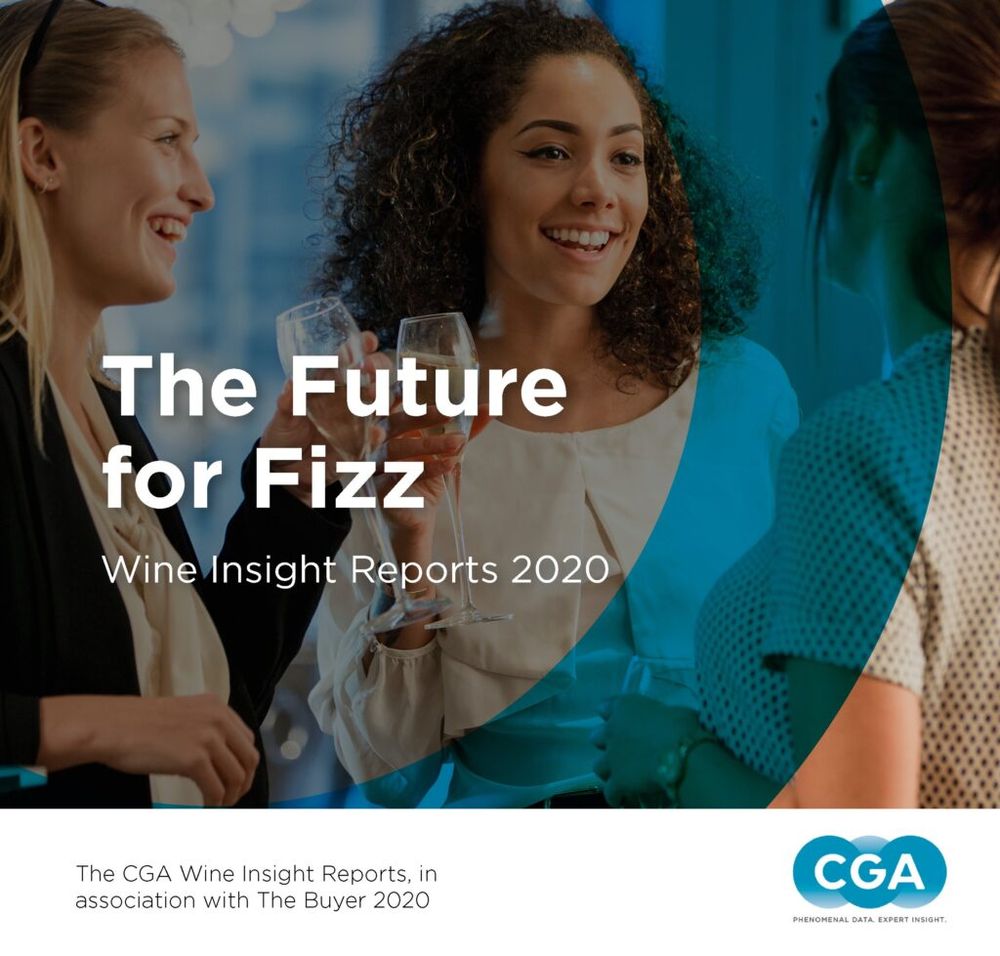The Future of Fizz is the third of four reports being released by CGA and The Buyer. You can find our more about the series here and click here for details on how to buy the sparkling report in general.
The UK’s seemingly insatiable appetite for sparkling wine could be ready to step up to another level once the on-trade is finally allowed to open its doors after the third national UK lockdown. For waiting in the wings are a raft of new drinking opportunities for sparkling wine that have been held back by the clamp down on all hospitality outlets in order to get on top of Covid-19.

The drink that makes perfect sense: combining the two most in demand categories, Prosecco and pink, rosé style wine in one glass.
Be it the launch of pink Prosecco at the end of last year, to more innovation across sparkling cocktails and spritz serves, alongside new packaging and design formats, the ‘fizz’ category is ready to burst once the on-trade hopefully returns in the spring and summer, according to CGA’s new ‘The Future for Fizz’ report – the most comprehensive report it is published on the category.
It brings together in-depth consumer behaviour research, sales trends, through to actual outlet data, combined with analysis on the overall sector by The Buyer. Together it provides a fascinating and in-depth overview of this vital and dynamic category for the hospitality sector as well as providing actionable insights for wine importers, distributors, producers and brand owners alike.
Pent up demand
The hope coming out of lockdown is the sparkling wine and Champagne sectors are best placed to capitalise on what is widely seen as the pent-up demand for people to be able to go out and share valuable time with friends and family and getting back to having some celebration in our lives.
‘The Future for Fizz’ reports looks specifically at how on-trade businesses and their suppliers can best prepare themselves for the relaunch of the on-trade and ensuring they have the right range and serve styles of sparkling wine and Champagne on their lists.
Key highlights

Some of the key highlights from the report include:
- Prosecco accounts for 85% of total sparkling wine volume in the overall on-trade (excluding Champagne).
- Over a third (35%) of on-trade wine drinkers drink sparkling wine or champagne when out.
- Sparkling rosé variants, including the new pink Proseccos being introduced, and more rosé Cavas, are expected to see major growth in the coming months and years.
- 15% of drinkers – around seven million people – say they would consider buying rosé style variants when they can, with younger adults particularly interested.
- There is a strong case for ensuring that a pricing ladder and/ or clear trade up opportunity is provided – with other options such as Cava and Crémant potentially able to include themselves in the mix as part of the steps between traditional value-led Prosecco positioning and House Champagne and above.
- Cocktails and spritzes are an important gateway to the category, with just under two thirds of those who could be attracted to spritzes being non-wine consumers.
- Home grown sparkling wine continues to rise with demand for English wine particularly in premium outlets, although price points in the short term after lockdown might “temper” growth.
- Crémant is growing in awareness but more needs to be done by suppliers to raise education and knowledge, but those that do choose crémant tend to be higher spenders.

Having the right of sparkling wines and Champagnes is going to be key factor for restaurants and bars as they re-open
“If the vaccine rollout progresses well and the on-premise can reopen smoothly, we may well see a major uplift in celebratory visits out—and that would bring excellent opportunities across the sparkling wine category,” says Mark Newton, CGA client director and wine category specialist.
“Spring and summer could be a great springboard for innovation and new product development across rosé, cocktails, longer mixed drinks and more, but operators and suppliers will need a deep understanding of consumers’ priorities and the latest trends in a dynamic market if they are to reap maximum benefits.”
Richard Siddle, editor-in-chief of The Buyer, adds: “This is the most comprehensive report I have seen that covers the most must have trends and insights of the sparkling wine and Champagne categories. What’s particularly exciting is that whilst the on-trade has largely been closed for the last 12 months, the activity and innovation in the sparkling category has never been greater, meaning it could be fit to burst when restaurants, bars and pubs can re-open their doors again. The arrival of pink Prosecco has already taken supermarkets and the off-trade by storm, but has arguably even more potential once we get into spring and the summer and the on-trade is back open again.”
CGA and The Buyer Reports
There are four reports in the CGA and The Buyer series, each offering insights on different areas of how wine is sold in the on-trade and how to maximise your sales. The four reports are:
The Wine Menu in Focus – out now
This first report examines the role of the wine list and wine menu in how consumers choose which wines to buy. Using sophisticated menu engineering analysis, it shows how businesses can best engage consumers and take advantage of increased use of digital devices at the table and busts some common myths about menus.

It shows that around three quarters (73%) of wine consumers use menus when deciding what to drink when they are out—and nearly half (44%) always do so. It examines the dynamics of managing a wine list during Covid when operators are limited to table service and have to use apps and online tools to engage with customers. But this new way of working is actually proving beneficial, particularly amongst younger age groups with one in three 18 to 34 year-olds preferring to use an online wine menu.
The report also looks at menu size and how many wines work best in a range – with a selection of 15 wines seen as the optimum number for many venues, with 40% of regular wine drinkers asking for menus with 11 to 20 wines on them.
“Given digital menus are far less structured and can be easily tweaked – now is the time to experiment with the likes of positioning, descriptions and costs,” says the report.
CGA’s Newton says: “It’s clear that menus have never been more crucial to guest engagement, and in 2020 it was often the only way to influence choice. They provide suppliers and operators alike with the chance to educate and entertain guests and inspire them to trade up—but in such a brief window for engagement, menu design and copy has to be spot on. With table service likely to be the norm for some time, it is so important to understand what does and doesn’t work on menus. Investing in menu optimisation now is very likely to pay off when people are able to enjoy drinking wine out of home again.”
Emerging Worlds & Global Origins – available now

If you are going to have a balanced wine range then you need to be listing wines from a wider range of countries, says CGA’s new Emerging Worlds & Global Origins report, the second in a series of four produced in partnership with The Buyer.
“Value, nostalgia, experimentation, and curiosity are all key drivers which can encourage sales.” That’s one of the key conclusions that CGA, the insights company focused on uncovering on-trade trends and statistics, makes when analysing which countries around the world consumers are increasingly turning to – and why.
This is the time to tap into the wanderlust that people will increasingly have in 2021, when the lockdown restrictions are lifted and the opportunity and ability to travel goes up, says CGA.
Over half of people (54%) are interested in discovering something new when out drinking in a bar or restaurant, according to the report. With the UK, Hungary and Romania high on the list of countries people are looking to explore.
The report looks into what steps a restaurant or bar can take to make them feel comfortable trying a wine from a country they have not tasted before – with 51% of these drinkers calling for free tasting samples.
The research also shows a substantial overlap of conservative and experimental drinking behaviour. More than a third (35%) of wine consumers say they find wines from emerging countries appealing, even if they prefer wines from traditional regions (34%).
Younger adults are more likely to choose these wines because of recommendations or to impress others, while older drinkers are more motivated by a desire to broaden their palates and horizons.
The Impact of COVID-19
The final report in the series sets out the huge impacts of the pandemic so far and looks ahead to more change. With valuable insights into consumers’ cautious new attitudes, it shows how to preserve wine sales amid turmoil and highlights opportunities to watch for in a post-COVID world.
- Each individual report is available for £875, and the complete set of four can be bought for £2,600 (excluding VAT). Click here for more information on all four. Contact CGA client director Mark Newton at mark.newton@cga.co.uk for more information.
- ‘The Future for Fizz’ report comes with a comprehensive PowerPoint deck of findings and a concise infographic executive summary. It is available for £875, or as part of a complete set of four Wine Insights Reports for £2,600 (excluding VAT).










































